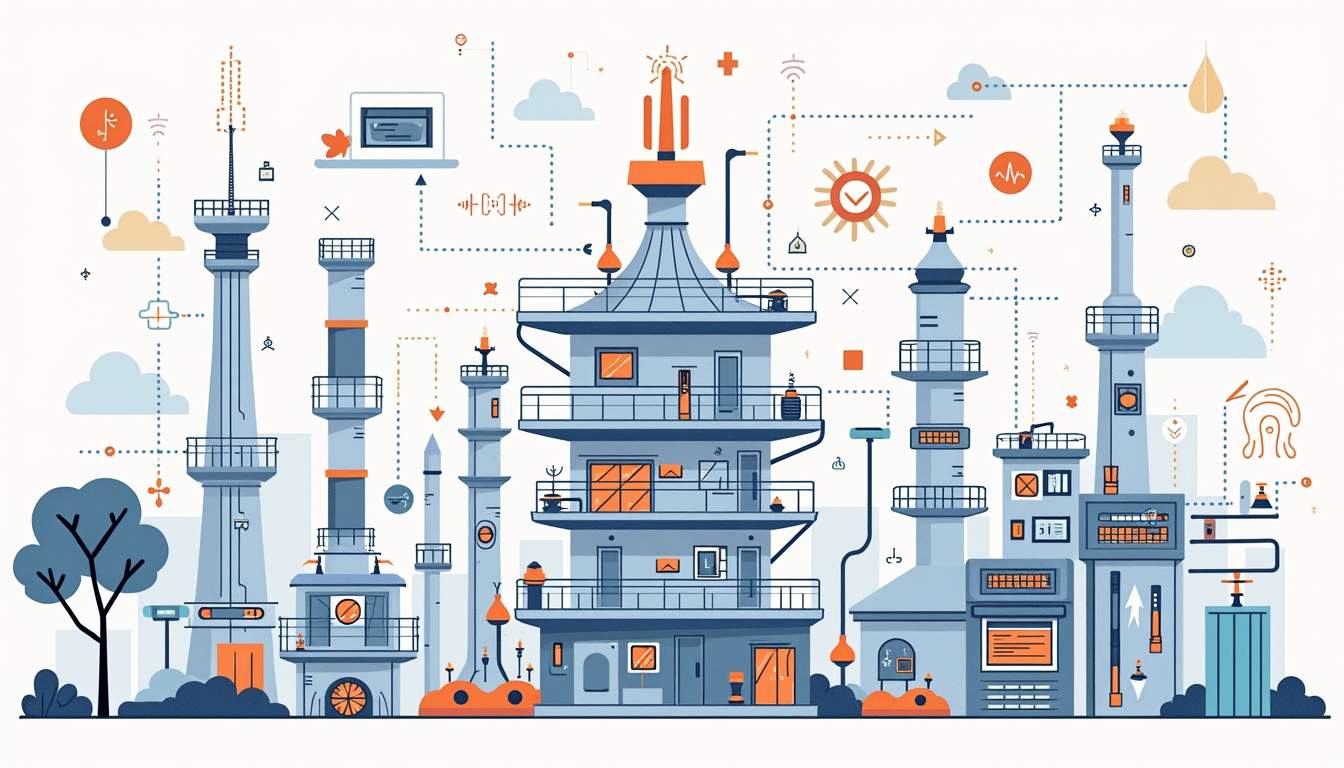Introduction to Smart Sensors
Smart sensors are advanced devices that collect, process, and transmit data about their environment. They are integral components of cyberphysical systems (CPS), which merge physical processes with computational elements. These sensors are equipped with embedded processing capabilities, allowing them to perform complex computations and analyses on the data they gather. The evolution of smart sensors has been driven by the need for real-time data acquisition and processing in various applications, including industrial automation, environmental monitoring, and smart cities.
In the context of cyberphysical plant design, smart sensors play a crucial role in enhancing operational efficiency, safety, and reliability. They facilitate the integration of physical systems with digital technologies, enabling seamless communication and control. The deployment of smart sensors in industrial settings allows for the continuous monitoring of equipment, processes, and environmental conditions, leading to informed decision-making and proactive maintenance strategies.
The significance of smart sensors extends beyond mere data collection; they are pivotal in enabling the Internet of Things (IoT) paradigm. By connecting various devices and systems, smart sensors contribute to the creation of intelligent environments that can adapt to changing conditions and user needs. This adaptability is essential for optimizing plant operations and achieving sustainability goals.
Types of Smart Sensors
Smart sensors can be categorized based on their functionality, application, and technology. Understanding the different types of smart sensors is essential for selecting the appropriate devices for specific cyberphysical plant design needs.
1. Environmental Sensors
Environmental sensors are designed to monitor various environmental parameters such as temperature, humidity, air quality, and light levels. These sensors are crucial for maintaining optimal conditions in industrial processes and ensuring compliance with environmental regulations. For instance, temperature sensors can help prevent overheating in machinery, while air quality sensors can monitor emissions and ensure a safe working environment.
2. Proximity Sensors
Proximity sensors detect the presence or absence of objects within a certain range. They are widely used in automation and robotics to facilitate object detection, collision avoidance, and material handling. Common types of proximity sensors include ultrasonic, infrared, and capacitive sensors. These devices enable efficient workflow management and enhance safety by preventing accidents in industrial settings.
3. Pressure Sensors
Pressure sensors measure the pressure of gases or liquids in various applications. They are essential for monitoring fluid dynamics in processes such as chemical manufacturing, oil and gas extraction, and water treatment. By providing real-time pressure data, these sensors help maintain system integrity and prevent failures due to overpressure or vacuum conditions.
4. Motion Sensors
Motion sensors detect movement within a defined area and are commonly used in security systems and automation applications. They can be passive, detecting changes in infrared radiation, or active, emitting signals to detect movement. In cyberphysical plant design, motion sensors can optimize energy consumption by controlling lighting and HVAC systems based on occupancy.
Key Features of Smart Sensors
Smart sensors possess several key features that distinguish them from traditional sensors. These features enhance their functionality and applicability in cyberphysical systems.

1. Data Processing Capabilities
One of the defining characteristics of smart sensors is their ability to process data locally. This capability allows them to filter, analyze, and interpret data before transmitting it to central systems. By reducing the amount of data sent over networks, smart sensors minimize bandwidth usage and enhance response times. Local data processing also enables real-time decision-making, which is critical in dynamic environments.
2. Connectivity
Smart sensors are equipped with various communication protocols, such as Wi-Fi, Bluetooth, Zigbee, and cellular networks, enabling them to connect seamlessly with other devices and systems. This connectivity is essential for creating integrated cyberphysical systems where data can be shared and analyzed across multiple platforms. The ability to communicate wirelessly also facilitates the deployment of sensors in remote or hard-to-reach locations.
3. Energy Efficiency
Energy efficiency is a crucial consideration in the design of smart sensors. Many smart sensors are designed to operate on low power, utilizing energy harvesting techniques or sleep modes to conserve battery life. This energy efficiency is particularly important in applications where sensors are deployed in remote locations or where maintenance access is limited. Advanced power management techniques ensure that smart sensors can operate for extended periods without requiring frequent battery replacements.
4. Scalability
Smart sensors are inherently scalable, allowing for easy expansion and integration into existing systems. This scalability is vital for cyberphysical plant design, where the ability to add or modify sensors as needed can significantly enhance operational flexibility. Organizations can start with a limited number of sensors and gradually expand their network as requirements evolve, ensuring that investments in technology remain aligned with business goals.
Applications of Smart Sensors in Cyberphysical Plant Design
Smart sensors have a wide range of applications in cyberphysical plant design, contributing to improved efficiency, safety, and sustainability. Their versatility allows them to be deployed in various sectors, including manufacturing, agriculture, energy, and transportation.
1. Manufacturing
In manufacturing, smart sensors are used to monitor equipment performance, track production processes, and ensure quality control. By collecting real-time data on machine conditions, operators can identify potential issues before they escalate, reducing downtime and maintenance costs. Additionally, smart sensors enable predictive maintenance strategies, where data analytics are used to forecast equipment failures and schedule maintenance proactively.
2. Agriculture
Smart sensors are revolutionizing agriculture through precision farming techniques. Soil moisture sensors, for example, provide farmers with real-time data on soil conditions, allowing for optimized irrigation practices. This not only conserves water but also enhances crop yields. Environmental sensors can monitor weather conditions, helping farmers make informed decisions about planting and harvesting times.
3. Energy Management
In the energy sector, smart sensors are essential for monitoring and managing energy consumption. Smart meters provide real-time data on electricity usage, enabling consumers to adjust their habits and reduce costs. In renewable energy applications, sensors monitor the performance of solar panels and wind turbines, ensuring optimal energy production and facilitating maintenance when necessary.
4. Transportation
Smart sensors play a critical role in intelligent transportation systems (ITS). They are used to monitor traffic flow, detect accidents, and manage public transportation systems. By collecting data on vehicle movements and road conditions, smart sensors contribute to improved traffic management and enhanced safety for drivers and pedestrians alike.
Challenges and Considerations in Implementing Smart Sensors
While the benefits of smart sensors are substantial, their implementation in cyberphysical plant design is not without challenges. Organizations must consider various factors to ensure successful deployment and integration.

1. Data Security and Privacy
As smart sensors collect and transmit sensitive data, ensuring data security and privacy is paramount. Organizations must implement robust cybersecurity measures to protect against unauthorized access and data breaches. This includes encryption, secure communication protocols, and regular security audits. Additionally, compliance with data protection regulations, such as GDPR, is essential to safeguard user privacy.
2. Interoperability
Interoperability is a critical consideration when integrating smart sensors into existing systems. Different sensors may use varying communication protocols and data formats, making it challenging to achieve seamless integration. Organizations must select sensors that adhere to industry standards and invest in middleware solutions that facilitate communication between disparate systems.
3. Cost and ROI
The initial investment in smart sensors can be significant, and organizations must carefully evaluate the return on investment (ROI). This evaluation should consider not only the direct costs of purchasing and installing sensors but also the potential savings from improved efficiency and reduced downtime. A comprehensive cost-benefit analysis can help organizations make informed decisions about sensor deployment.
4. Maintenance and Support
Regular maintenance and support are essential for ensuring the long-term functionality of smart sensors. Organizations must establish maintenance protocols to address issues such as sensor calibration, battery replacement, and software updates. Additionally, having a support system in place for troubleshooting and repairs can minimize disruptions to operations.
The Future of Smart Sensors in Cyberphysical Plant Design
The future of smart sensors in cyberphysical plant design is promising, driven by advancements in technology and the increasing demand for automation and data-driven decision-making. As sensor technology continues to evolve, we can expect several trends to shape the landscape of smart sensors.
1. Enhanced AI Integration
Artificial intelligence (AI) is set to play a significant role in the future of smart sensors. By integrating AI algorithms, smart sensors can improve their data processing capabilities, enabling more sophisticated analyses and predictions. This integration will enhance the ability of organizations to make data-driven decisions and optimize processes in real-time.
2. Miniaturization and Cost Reduction
As technology advances, we can expect the miniaturization of smart sensors, making them smaller, more efficient, and less expensive. This reduction in size and cost will facilitate the widespread adoption of smart sensors across various industries, including those with previously limited access to such technologies.
3. Increased Focus on Sustainability
With growing concerns about environmental sustainability, the future of smart sensors will likely emphasize energy efficiency and eco-friendly practices. Sensors that monitor energy consumption, waste generation, and resource usage will become increasingly important in helping organizations achieve their sustainability goals.
4. Greater Connectivity and Integration
The proliferation of IoT devices will lead to greater connectivity and integration of smart sensors within cyberphysical systems. As more devices become interconnected, the potential for data sharing and collaboration will expand, enabling organizations to create more intelligent and responsive environments.
Conclusion
Smart sensors are a cornerstone of cyberphysical plant design, providing the data and insights necessary for optimizing operations, enhancing safety, and promoting sustainability. Their ability to collect, process, and transmit data in real-time makes them invaluable in various applications, from manufacturing to agriculture and energy management. Despite the challenges associated with their implementation, the benefits of smart sensors far outweigh the drawbacks, paving the way for a more efficient and intelligent future.

As technology continues to advance, the role of smart sensors in cyberphysical systems will only grow, leading to new opportunities for innovation and improvement across industries. Organizations that embrace smart sensor technology will be better positioned to navigate the complexities of modern operations and achieve their strategic objectives.
Transform Your Operations with Cybersort
Ready to harness the power of smart sensors and elevate your cyberphysical plant design? At Cybersort, we’re committed to helping you leverage your plant data to its fullest potential. Our platform is tailored to streamline your data management, bolster security, and boost operational efficiency. Don’t miss out on the opportunity to transform your organization’s approach to real-time data and decision-making. Book a discovery call with us today and take the first step towards a smarter, more connected future.


